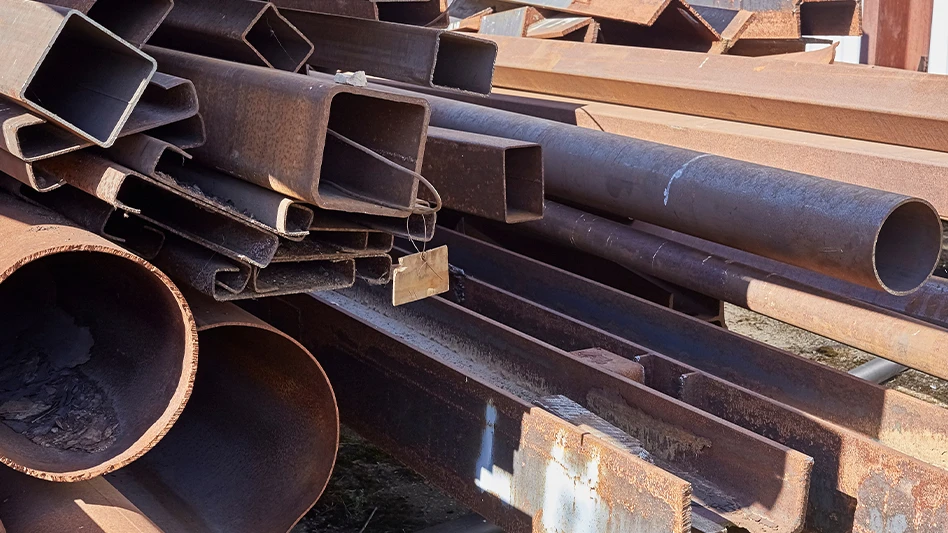

Recovering scrap metal is an important function of most demolition jobs as demolition contractors often encounter significant amounts of metal on the job site. However, best practices for handling that material could vary on a case-by-case basis.
“We try to be consistent, but you do have to adapt based on where you’re at and who you’re dealing with,” says Michael Kelly, chief financial officer at Schenectady, New York-based Jackson Demolition Service Inc. The company serves residential, industrial and federal clients throughout the United States.
“There are variables, such as what the client will allow you to do and what they won’t allow you to do,” he says. “So, it’s a coordinated effort.”
Mark Ramun, vice president of industrial sales at Jackson Demolition, adds that every job has different factors to take into consideration, such as how to handle the scrap material, where to sell it and how to transport it.
“Anything that can be recycled or reused, we want to recycle or reuse to avoid the need to put it in a landfill or somewhere else,” Ramun says. To achieve this, Jackson Demolition extracts materials in a manner in which the company will recover the highest value for them. The demolition firm also sorts and segregates metals by type and grade consistent with the requirements set by recyclers and mills.
Getting the grade
Identifying scrap metal is one of the first steps Jackson Demolition takes when recovering metals from its job sites.
Jackson Demolition recently finalized a project at Southern Co.’s retired Gorgas Electric Generating Plant, better known as Plant Gorgas, in Parrish, Alabama. The plant served as a coal-fired power station.
“When we got to that site, we recognized there would be a lot of grades of materials,” Ramun says, noting the company has encountered more than 70,000 gross tons of steel on the site.
To identify scrap metal on its job sites, Jackson Demolition uses Niton XL2 X-ray fluorescence (XRF) guns from Thermo Fisher Scientific in Massachusetts. For the Gorgas project, XRF guns identified grades that otherwise would have been difficult to categorize visually.
“We were able to capitalize on recovering metals that were exotic [that] we would not have been able to identify without the XRF,” he adds. “That helps our project team identify materials that might be of higher value to separate them.”
Kelly says the company has seven or eight XRF guns to ensure one is available at each job site.
“They’re $25,000 to $30,000 but well worth it because [they] will identify the difference between a 304 stainless, which you might get 60 cents a pound [for], versus a 316 stainless, which you could get 90 cents a pound [for],” Kelly says. “If you didn’t know the difference, you would send it out blind and rely on a scrap yard to reimburse you correctly.”
Ramun says Jackson Demolition also refers to industry specifications such as those produced by the Institute of Scrap Recycling Industries, Washington, when identifying different grades of materials.
He adds that good communication is key to making sure materials are properly identified and sorted on-site.
“We spend a pretty good amount of time explaining to them where the materials [are] going and what they’re being used for,” Ramun says. “It’s really important to share with your team why they’re doing what they’re doing.”
Preparation decisions
Once a demolition contractor identifies scrap metal on a site, the company then decides where to sell the material. A contractor can either sell the scrap to a scrap yard for additional processing or directly to a mill. While a mill might pay more for that material than a scrap yard, that option often requires demolition contractors to further process scrap on-site.
With each job, Kelly says Jackson Demolition determines how much it will cost to process the metals generated during the demolition process on-site, how much a mill or scrap yard will be willing to pay for the metal and the transportation costs.
“It’s a balancing act of logistics, the trucking that’s involved, how much you prep or don’t prep and what can that be in the way of a price savings for you,” Kelly says.
In many cases, processing materials on-site can cost more than it’s worth. “We know the cost per ton to process steel,” he explains. “When we get a price from a scrap yard or a mill, the [cost] difference between [a prepared load] and an unprepared load is often lower. So, what we often elect to do is to take the unprepared price and just concentrate on volume and getting as much material as we can out the door to [a scrap yard].”
Ramun says that was the case with the Gorgas project. Jackson Demolition was unable to shear that metal further on-site, so the company decided to sell the scrap metal to a nearby scrap yard.
Kelly says selling scrap metals to scrap yards rather than processing the material on-site itself helps to extend the life of the company’s equipment by reserving it for when it’s most needed. He adds that scrap yards tend to have equipment that handles metals more efficiently and economically.
“When we’re dealing with a scrap yard, the scrap yard has built-in mechanisms for a lot of volume of steel,” Kelly says. “They have the equipment we would not have. They have guillotine shears, which can handle massive amounts of steel. They have balers.”
Jackson Demolition used to process more material in-house; however, Ramun says that practice is less common now.
“It’s becoming more common now for us to find recyclers that are willing to process material for less than what we could process it,” Ramun says. “So, it’s always a calculation that has to be run at the time that you’re bidding the work and also at the time that you’re performing the work.”

Moving materials
Scrap metal prices fluctuate regularly based on evolving market conditions as well as by grade. Ramun says the company closely watches the prices to have an idea of what it will receive for the materials it generates on a job site.
Regardless of changing prices, Kelly says Jackson Demolition likes to quickly move ferrous scrap from a job site to clear the site and ensure good quality material.
“On average, as we take [the] material down, the material is normally off-site within less than 10 days. It’s not staying on-site very long at all,” he says. “We bring trucks right out to the demolition pad that we’re working on, and we’ll create piles right where we’re working and load from those piles into the trucks.”
Kelly says the company occasionally decides to store nonferrous materials on-site to safeguard them before they are transported to the scrap buyer.
Trucking is one of the most common ways to transport materials from demolition job sites; however, Kelly says Jackson Demolition has relied on rail to transport materials to scrap buyers in instances where the buyer is far from the site.
“We’ve used rail access in the states of Maine and Texas just because of the sheer distance involved from the job site to the end users that were going to be receiving the material,” he says. “Logistically, it would not have made sense to try and truck a load of steel 10 hours to a recycler. So, in those cases, we have used rail.”
Aside from those instances, Jackson Demolition largely relies on trucks to move materials off-site. Kelly says the company tries to sell to buyers that are relatively close to the job site and makes sure to fill trucks as much as possible to lower transportation costs.
“Normally buyers give us a set rate per load,” he says. “Say, it’s $250 a load, we’re going to want to fill up those trucks as much as we can because that’s going to be a deduction against us. So, if it was $250 a load and we could get 15 tons into it, that is going to cost us $16 a ton. If we were able to get 20 tons into it, it’s going to be about $12.50 a ton. We look to load the trailers to their legal limit and take advantage of the volume of trucks that we get during the course of a day.”

Explore the April 2023 Issue
Check out more from this issue and find your next story to read.
Latest from Recycling Today
- BMW Group, Encory launch 'direct recycling’ of batteries
- Loom Carbon, RTI International partner to scale textile recycling technology
- Goodwill Industries of West Michigan, American Glass Mosaics partner to divert glass from landfill
- CARI forms federal advocacy partnership
- Monthly packaging papers shipments down in November
- STEEL Act aims to enhance trade enforcement to prevent dumping of steel in the US
- San Francisco schools introduce compostable lunch trays
- Aduro graduates from Shell GameChanger program





